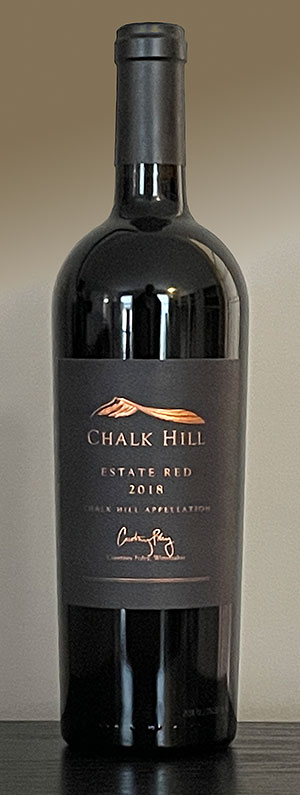
One fine spring day in 1972, attorney, private pilot, and wine aficionado Fred Fruth was piloting his plane over the Russian River Valley area. Down below, he hoped he saw what he had been searching for: a property that had the climate and soils to grow first-class wine grapes. Furth and his second wife, Peggy, purchased the land, named the estate Chalk Hill, and started producing wine about a decade later. They gradually planted more than 270 acres of vines. Years later, Furth said, “I have always been interested in wine because my grandfather had vineyards. I’m actually more interested in the working-the-soil aspect, but I have many very talented people in the winery who know how to produce a world-class wine. When I bought this property, I was told it was too hilly to be a vineyard, but I simply planted the grapes in rows going uphill. People said you can’t do that, but I’d seen it done in Germany so I knew it would work.” After a rich and varied life, Furth died in 2018 at the age of 84.
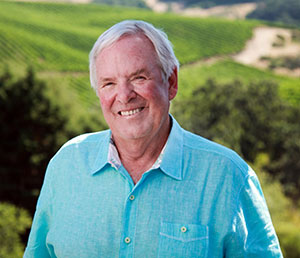
Lawyer Bill Foley acquired Chalk Hill in 2010. Although Foley is titled as “vintner,” I doubt he sees the interior of the winery very often. He is a vintner in the broader sense of “someone who sells wine.” He also owns the National Hockey League’s Vegas Golden Knights, is the Executive Chairman of the Board of Directors for Fidelity National Financial Inc., is Vice Chairman of the Board of Directors for Fidelity National Information Services, Inc., and owns fifteen other wineries.
The Estate
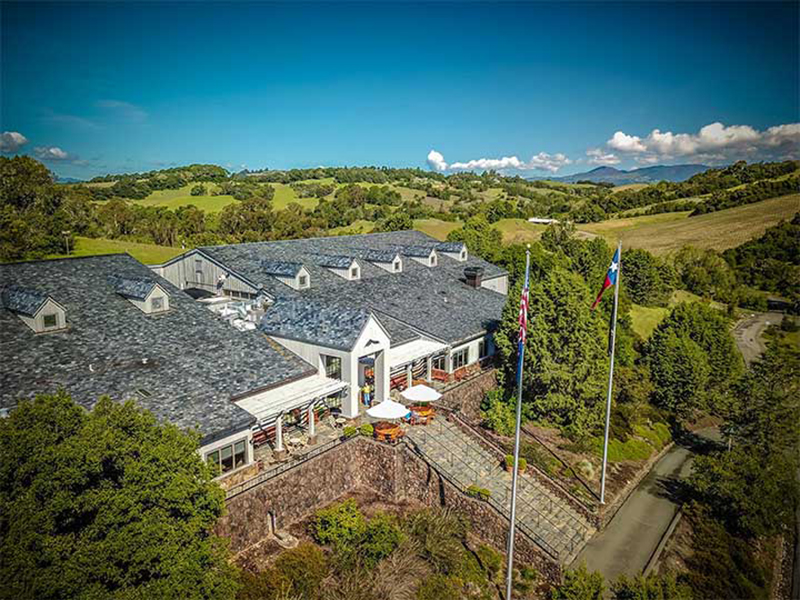 x
x
The Chalk Hill AVA is one of 13 in Sonoma County, and is distinguished from the neighboring appellations of the cooler Russian River Valley to the west and the warmer Alexander Valley to the northeast. Elevations are higher and soil fertility is lower. The soils include gravel, rock, and heavy clay. Under the topsoil is a distinctive layer of chalk-colored volcanic ash which inspired the name of Chalk Hill.
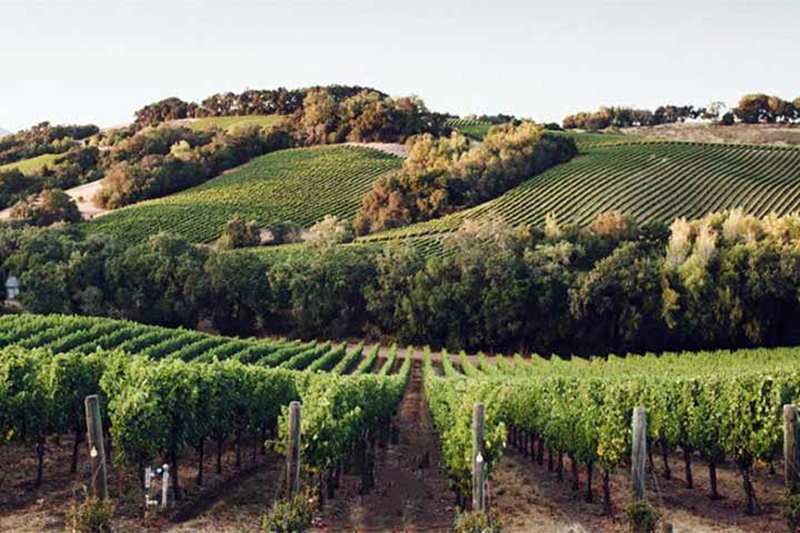 x
x
Each vineyard block has been planted based on criteria that include: soil profile and chemistry, slope, orientation to the sun, and climate. Under Fred Furth’s direction, Chalk Hill was an early leader in planting its hillside vineyards “vertically,” following the rise of the terrain, rather than across it. Because of this, the topsoil must be protected with a diverse cover crop serving many purposes. It anchors and protects the soil, preventing erosion; captures and affixes nitrogen; and harbors a varied community of beneficial insects that aid in pest management. Water conservation is addressed through a precisely controlled drip-irrigation system.
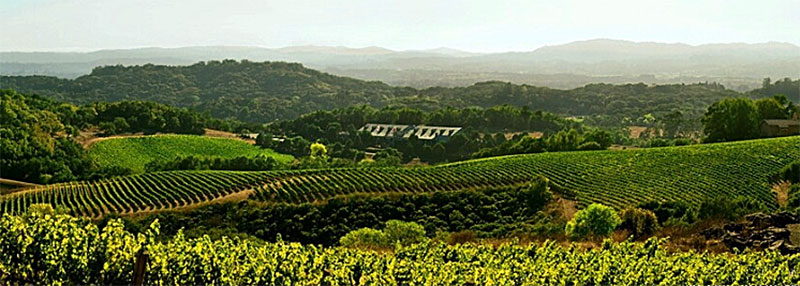
Photo: devonwayne.com
More than two-thirds of Chalk Hill’s 1300 acres remain uncultivated. In addition to the vineyards, the property features wilderness areas, the winery, a hospitality center, a culinary garden, a residence, stables, and an equestrian pavilion.
The Winemakers
Michael Beaulac, Senior Winemaker
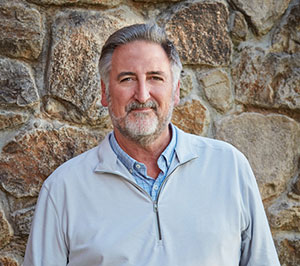
Beaulac, a Vermont native, is senior winemaker, bringing with him over thirty years of experience. He began his winemaking career when Tim Murphy of Murphy-Goode offered him a job as a harvest intern in 1989. Immediately after and through 1991 he worked as a cellar master with long-time Russian River winemaker Merry Edwards. Beginning in 1997, he spent four years as winemaker for Markham Vineyards in St. Helena. He became Vice President of St. Supéry Vineyards in Rutherford in 2001, working closely with Michel Roland and Denis Dubourdieu. Beaulac was general manager and winemaker at Napa’s Pine Ridge Vineyards from 2009 until coming to Chalk Hill this year.
Darrell Holbrook, Winemaker
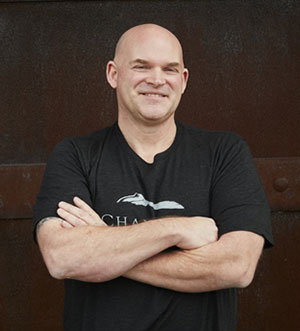
A Sonoma County native, Holbrook spent his childhood among the vineyards there. By age 12, he often accompanied his father to his job at Lytton Springs Winery, [now Ridge Vineyards] driving tractors and helping where he could. In 1994, after working at Lytton Springs in the vineyards, he began an apprenticeship under David Ramey, Chalk Hill’s winemaker at the time. He worked his way up from a cellar intern (aka cellar rat) to enologist and production manager, and then assistant winemaker in 2009. Ten years later he was promoted to winemaker.
Courtney Foley, 2nd Generation Vintner
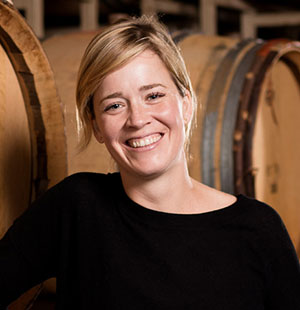
The youngest daughter of Chalk Hill Estate proprietors Bill and Carol Foley, she studied enology and viticulture at both Napa Valley College and Fresno State University. Her practical experience began under winemaker Leslie Renaud at Lincourt Vineyards and Foley Estates (surprise!) in Santa Barbara County. Once back in Sonoma, she again found herself working with Renaud at Roth Estate Winery in Healdsburg. Just in case the wine thing doesn’t work out, she also has a J.D. degree with a focus on Environmental and Ocean Law from the University of Oregon School of Law.
Chalk Hill Chalk Hill Estate Red 2018
This selection, a blend of 54% Cabernet Sauvignon, 34% Malbec, 10% Petit Verdot, and 2% Carmenere. Primary fermentation was in stainless steel, followed by 100% malolactic fermentation with batonnage. It was then aged 21 months in 61% new French oak. It was bottled unfined and unfiltered. It is a rich, deep red in the glass, quite dark but completely transparent. The nose offers up aromas of cedar and complex dark fruit. These express on the full-bodied palate as tart cherry and sweet prune, with some spice and a hint of cigar box. This is all supported by grippy black tea tannins and balanced acidity. ABV is 15.5%. This would pair quite nicely with a meatloaf.
Chef Alec’s Meatloaf
Chef Alec is Chalk Hill Estate Vineyards’ onsite chef who oversees the culinary program there.
Serves 10 – 12
INGREDIENTS
2 lbs. ground chuck
1 lb. mild Italian sausage
1 cup breadcrumbs
2 large eggs
1/2 large yellow onion, diced
2 Tb. garlic, minced
2 Tb. BBQ rub
2 lbs. bacon*
1 cup tomato paste
1 cup truffle BBQ sauce**
Salt and pepper to taste
DIRECTIONS
- Preheat oven to 300 degrees F.
- In a large bowl, combine ground chuck, sausage, breadcrumbs, eggs, onion, garlic, and BBQ rub. Season with salt and pepper. (Sear a small piece in a pan and taste to check seasoning.)
- Cover a large cutting board with plastic. Lay strips of bacon vertically along the cutting board and weave slices horizontally to create a lattice. (Visit Youtube for helpful videos on how to do this.) Center the meat mixture in the middle of the lattice, and wrap using the plastic to help keep the bacon in place.
- Remove plastic and place the meatloaf on a foil-lined baking sheet. Bake for 1 hour.
- Combine tomato paste and truffle BBQ sauce, spread evenly over meatloaf. Turn the heat up to 450 degrees F and continue to cook until BBQ tomato paste mix is deeply caramelized and internal temperature is 145 degrees F, checking often. About 20 to 30 minutes
- Remove from oven and let rest for 20 minutes .
*You will only need 2 lbs of bacon if you use thick cut. However, the bacon doesn’t crisp (which my wife didn’t like), it just bastes the loaf. You are probably better off with 1 lb. of regular cut.
**Available at Trader Joe’s, or add truffle salt to your favorite BBQ sauce, which is what I did.
Note: This selection is guilty of Bloated Bottle Syndrome, which I’m calling out for bottles that weigh more than the wine they contain. The web site of nearly every winery will usually include a mention of the operation’s dedication to “sustainability” and “stewardship.” Unfortunately, this often seems only to extend to the property itself. Many “premium” wines like this one come in heavier bottles to allegedly denote quality. This one weighs in at a hefty 876 grams. (As an example of a more typical bottle, Estancia Cabernet’s comes in at 494 grams.) That’s a lot of extra weight to be shipping around the country. By comparison, the wine inside, as always, only weighs 750 grams. Even sparkling wine bottles often weigh less than this one, and those are made to withstand high internal pressure. Unfortunately, this sort of “bottle-weight marketing” is becoming more common, especially at higher price points. But there are other ways to denote quality without weight: unusual label designs, foils, wax dipping, etc.
Plastic bottles have a lower environmental impact than glass, 20% to 40% less, in fact. And, bag-in-box packages are even less than plastic bottles. (Unfortunately, current bag technology will only keep unopened wine fresh for about a year, so they are only suitable for wines to be consumed upon release from the winery; that’s about 90% of all wine sold though.)
The carbon footprint of global winemaking and global wine consumption is nothing to scoff at. The latter, which requires cases of wine be shipped around the world, imprints a deep carbon footprint. Because wine is so region-specific, and only so many regions can create drinkable bottles, ground and air transportation is responsible for nearly all of the wine industry’s CO2 emissions.
Back to blog posts: https://winervana.com/blog/
